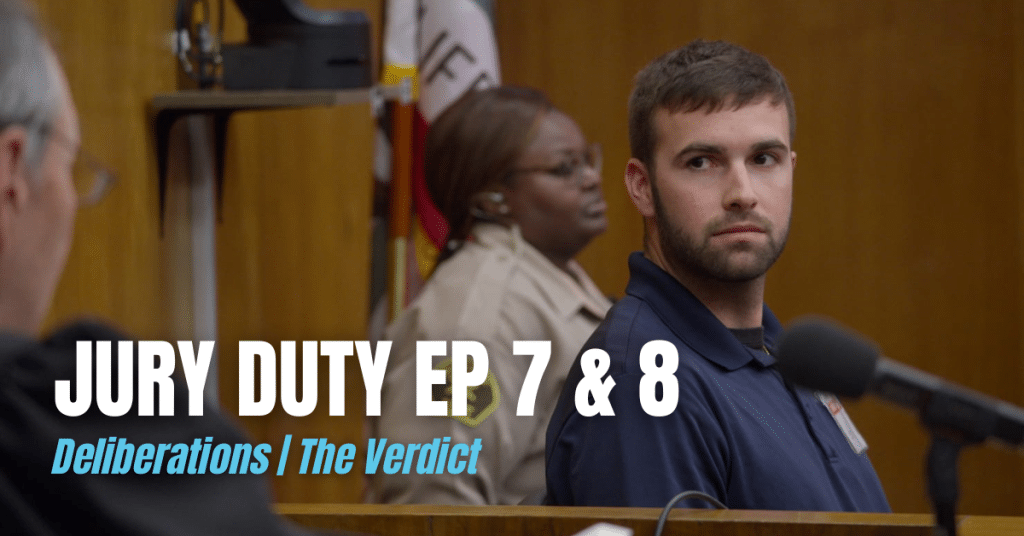In our final installment of the review of the series Jury Duty, we are taken into the deliberation process that a jury goes through in order to render a verdict on the case. In these last two episodes we are exposed to two themes that have been alluded to throughout the entire series. The first is the importance of the foreperson in the jury room, and the second is just how difficult it can be for a jury to come to a unanimous verdict during the deliberation process.
The Role of the Foreperson
The importance of the role of the foreperson has been on display throughout the entire series, and this theme is especially on display in the final two episodes. At the beginning of this episode, we are taken behind the curtain and into the deliberation process of the jury in this case. Ronald’s role as the foreperson is to lead the discussion of the entire jury and allow an analysis to take place that leads the jury to come to a unanimous decision regarding the liability of the defendant in this case. It has been emphasized by the judge throughout the trial that the role of the foreperson is to lead the jury and that is highlighted when the jury is going through the deliberation process. During their time deliberating, the members of the jury take a vote to see what everyone was thinking after a discussion about the evidence presented in the case, the room was fairly split on their decision of liable or not liable.
This is the time where the role of the foreperson is really on display in this episode. Ronald began to lead a discussion about the reasons why the members of the jury voted liable or not liable. In a scenario that could lead to a lot of argument or disagreement, Ronald was able to lead the discussion in a positive manner that evaluated all of the evidence presented and testimony heard throughout the trial. This is a great example of how a deliberation could take place in real life. There is not normally going to be a unanimous agreement about anything in life, and in the courtroom, it is highlighted due to the necessity for the jury to come to a unanimous decision.
The Unanimous Verdict
The theme of the struggle to achieve a unanimous verdict is also on display thought the episode. Similar to an actual trial, the jury is tasked with coming to a unanimous decision on the case in order for the judge to enter a verdict concluding the trial. This is one of the challenges that a jury is faced with in real life, and it is not always an easy task to complete. As a result, sometimes juries can be in the deliberation process for a long time in order to achieve a unanimous verdict. There were two instances in their deliberation process that showed the challenge that the jury could face when coming to a decision.
The first occurred when each of the members of the jury began to talk about the evidence that was not allowed into the trial by the judge. The judge specifically told the members of the jury that they were to disregard any information that they heard about chemicals that were mentioned by the defendant in his closing statement. The reality of the situation is that the members of the jury did hear what the defendant had to say about the chemicals. In addition to hearing the defendant speak about the chemicals in the factory, a few members of the jury discovered a large amount of chemicals during their site visit to the factory. It is difficult for the jury to completely disregard what the defendant had said because they had witnessed the chemicals with their own eyes. This is something that can happen in a real trial as well, because when an objection to a statement is made in the court, they cannot just wipe the memory of the jury. The jury is going to have the memory of what they heard in the courtroom although the judge told them to disregard that information.
Additionally, the second instance that showed the challenge that a jury could face comes up with the penultimate vote for the verdict. Everyone on the jury had changed their vote to not liable after a positive discussion with the group except one person. Since they did a blind vote the members of the jury did not know who the one holdout was but that is not an uncommon thing to happen in a deliberation room. Eventually the lone holdout is able to be swayed to change their vote and the jury comes to unanimously find the defendant not liable on all charges. This is a great example of how much of an effect that one member of the jury can have on the deliberation process. Due to the need to come to a unanimous decision, one person not agreeing with the rest of the jury could prevent a decision from being made to resolve the case.
In real life the lone holdout is usually based on the opinion of the juror about the validity or invalidity of the evidence presented in the case. In this instance the holdout on the jury had nothing to do with the case, and he just did not want to go home because he enjoyed being with the other members of the jury. This is not a scenario that would likely occur in real life, especially with a sequestered jury.
Series Conclusion
The series concludes with the judge explaining to Ronald that he was on a reality tv show and that everyone that he has been interacting with over the length of the trial was an actor. The remainder of the episode revolves around the cast and crew explaining how they were able to convince Ronald that it was a real trial. After it is revealed to Ronald that everything was a tv show, he is taken behind the scenes and see how they were able to pull off the show without him finding out. While this is a humorous and entirely fake show, it gives a little insight to the audience into the things that happen while someone is serving on a sequestered jury. The issues that come up throughout the series are issues that come up in real life as well but portrayed in an extremely humorous way.


